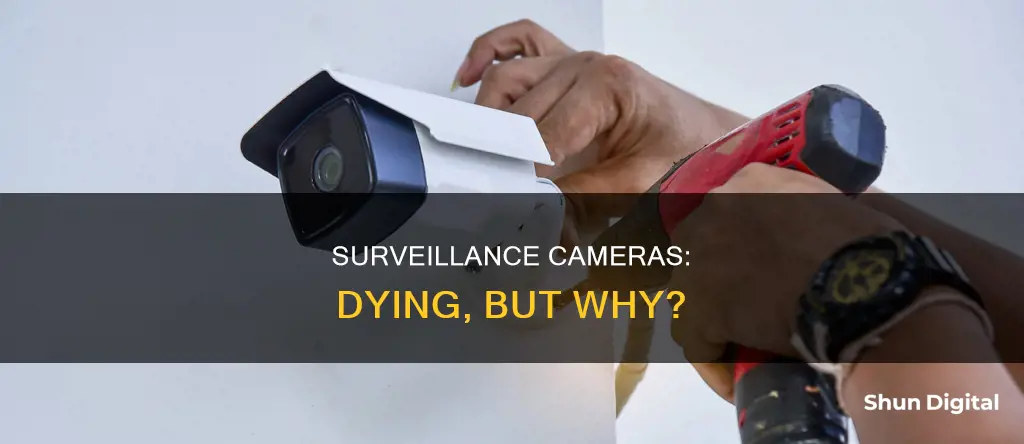
Surveillance cameras are an important tool in the fight against crime and terrorism, but they also come with privacy concerns. As cameras approach the end of their lifespan, they display several signs of deterioration, including diminished image quality, connectivity issues, and irregular motorized movements. While these cameras aid in crime prevention and property protection, there are ongoing debates about the ethical implications of their usage, such as the potential invasion of privacy and the risk of abuse by those monitoring the footage. Regular maintenance and proactive monitoring of surveillance cameras can help identify failing equipment and maintain the effectiveness of security systems.
What You'll Learn

Diminished image quality
One of the most common signs that a surveillance camera is failing is diminished image quality. This can manifest as a decline in clarity, sharpness, or colour accuracy in the video feed. For example, the footage may become blurry or pixelated, with anomalies such as distortion or a loss of colour accuracy. In some cases, the camera may struggle with low-light performance, resulting in faded infrared capabilities or difficulty adapting to varying lighting conditions. These issues can be attributed to malfunctions in the camera's hardware, such as problems with the sensor, lens, or other critical components.
To address potential image quality issues, it is recommended to regularly review the footage and inspect for any anomalies. Modern surveillance systems often come equipped with diagnostic tools that provide real-time health monitoring, including alerts and notifications related to image quality concerns. Some systems even generate automated reports on the condition of each camera. Additionally, firmware updates and occasional camera replacements can help ensure optimal performance and longevity.
The placement of the camera can also impact image quality. For example, if the camera is mounted too high or too far away from the area being monitored, the footage may appear grainy or blurry when zoomed in on specific details. This is a common issue with wide-angle shots or when the video is cropped to focus on a specific area of interest, such as a person's face or a license plate.
Another factor contributing to diminished image quality is the compression and resolution of the footage. Surveillance cameras often record footage continuously, resulting in large file sizes. To manage storage space, the video may be internally compressed before recording, reducing its visual quality and resolution. This compression can lead to graininess and blurry edges, especially when the footage is cropped or zoomed in on.
Furthermore, external factors such as dirt, dust, or water can also impact image quality. Cameras with small lenses or those placed in areas prone to dirt and debris may experience a buildup of dust or spider webs, requiring regular cleaning or replacement. Additionally, cameras exposed to inclement weather conditions may be susceptible to water damage, which can negatively affect image quality.
Congestion Charge Cameras: Effective or Invasive?
You may want to see also

Connectivity issues
Next, check your internet connection and router settings. If you've recently changed your internet provider, your IP address may have changed, causing external connection problems. If your router has been replaced, you will need to configure the firewall and port configuration settings.
Physical components such as cables, connectors, and power sources should also be inspected. Tangled or kinked cables could be the culprit, or the cables may simply be loose or not properly connected to the correct ports.
If your cameras are wireless, check the antennas are fixed and tightened to the camera. Wireless cameras may also experience signal interference, so ensure the camera is not too far from the router and that there are not too many barriers (such as walls) between the two.
Finally, check for IP conflicts. Each camera should be assigned a unique IP address. If there is another device using the same IP address, this will cause an IP conflict and a malfunctioning camera.
Latest Adobe Camera Raw: Unlocking Raw Power
You may want to see also

Flickering or no video
Surveillance cameras are susceptible to a variety of issues that can cause them to malfunction, including problems with video playback. Here are some tips to address issues with surveillance cameras that are experiencing flickering or a lack of video:
Flickering Video
Flickering video is often caused by a mismatch in frequencies between the camera and the light source. This issue is more likely to occur with fluorescent lighting. The frame rate of the camera should be divisible by the number of light pulses to avoid flickering.
For areas with a 60 Hz AC power supply (common in North America), the camera's frame rate can be set to 30 fps, 60 fps, or 120 fps. For areas with a 50 Hz AC power supply (common in Europe, Africa, and Asia), ideal frame rates are 25 fps, 50 fps, or 100 fps. However, these frame rates may not be achievable, in which case the issue can be mitigated by adjusting the shutter speed.
Most modern cameras have "Flicker-less" or "Flicker-free" settings to address this problem, which can usually be found under the Exposure Setup.
No Video
If your surveillance camera is not displaying any video, there are several potential causes and solutions to consider:
- Check the camera's connection and power supply: Ensure that all connections are correct and the camera is receiving power.
- Verify the cabling: Connection issues often arise from cabling problems. Try using another cable to connect the camera and see if the problem persists. For PoE security cameras, it is recommended to use a Cat 6 or Cat 5 Ethernet cable.
- Review the camera settings: Ensure that the camera's settings are configured correctly, including features like 24/7 recording, motion detection alerts, and night-time recording.
- Reboot the camera: Power cycle the camera by unplugging the power supply, waiting a few seconds, and then plugging it back in.
- Check for IP address conflicts: Each IP security camera should have a unique IP address. Use the Command Prompt on a connected computer to check for IP conflicts. If a conflict is detected, change the camera's IP address.
- Update the camera's firmware and software: Check the manufacturer's website for the latest firmware updates to fix any issues or glitches. Additionally, update the client software used to connect to the camera to ensure compatibility.
- Reset the camera to factory defaults: Most cameras have a reset button or a pinhole reset function. Performing a factory reset will restore the camera to its default settings, and you will need to re-enable any desired features.
- Consult the manufacturer's FAQs and tech support: Many manufacturers provide detailed FAQs on their websites to address common issues. If further assistance is needed, contact their technical support team for help.
By following these steps, you can effectively troubleshoot and resolve most issues related to flickering or a lack of video with your surveillance cameras.
Water-damaged Cameras: How Did This Happen?
You may want to see also

Inconsistent recording
Modern surveillance systems are often equipped with motion detection and AI-based analytics capabilities. Unreliable operation or inconsistent performance of these functions may suggest a deterioration in the camera's overall performance. It is crucial to monitor notifications or alerts triggered by unusual activity, as a decline in the camera's ability to accurately detect and report events could foreshadow impending issues.
To address inconsistent recording, it is essential to regularly inspect the physical condition of the camera, including the lens, cables, and power source. Environmental factors, such as extreme weather or tampering, can contribute to the wear and tear of surveillance equipment. Prompt attention to these issues is vital to maintaining the effectiveness of the surveillance system and ensuring reliable monitoring.
In addition, it is important to ensure that the camera's settings are optimised for its full capability. Some features may be on default settings and require manual enabling or customisation. Checking the camera's settings can help ensure that all security features are enabled and functioning correctly.
Furthermore, inconsistent recording may be a result of poor cable connections or a fluctuating internet connection. It is recommended to check that all connections, cables, and power sources are intact and tightly connected. For wireless cameras, ensuring a stable internet connection and verifying that the camera is successfully connected to the WiFi network can help resolve inconsistent recording issues.
In some cases, inconsistent recording may be caused by outdated software or firmware. Regularly updating the camera's software and firmware to the latest versions can enhance compatibility and improve overall performance, including consistent recording.
Caught on Camera: Signing for Trap Tickets
You may want to see also

LED lights malfunctioning
One of the main issues with LED lights is their interference with the camera's image sensor. LED lights flicker at a very rapid rate, and the camera's shutter speed can capture these gaps in light, causing interference in the form of horizontal black lines in the footage. This issue can be mitigated by adjusting the camera's shutter speed or setting the Anti-Flicker to 50Hz or 60Hz.
Another concern is the glare caused by LED lights. Their high brightness can create glare on camera lenses, resulting in blooming and streaking in the footage. This can be addressed by using multiple lower-wattage lights instead of a few high-powered lights, ensuring that the lights are positioned higher than the camera, or using shielded bulbs that direct the light away from the camera.
In addition, LED lights can also illuminate hidden cameras, compromising their stealth. This is particularly relevant in areas where discreet surveillance is required. To mitigate this issue, it is recommended to position the lights out of the camera's view and ensure that the lighting fixtures are not in the direct line of sight of the camera.
Furthermore, LED lights can also cause issues with motion detection in surveillance cameras. While LED lights can be instantly turned on or off, which is advantageous for motion detection, they can also trigger false positives or interfere with the camera's motion sensors. Ensuring proper synchronization between the lights and the camera's motion detection settings is crucial to minimize these issues.
To summarize, LED lights malfunctioning in surveillance cameras can lead to issues such as diminished image quality, interference with the image sensor, glare on camera lenses, illumination of hidden cameras, and challenges with motion detection. However, by making adjustments to shutter speed, light positioning, and wattage, these issues can often be resolved or mitigated.
Surveillance Cameras: Objectives and Benefits
You may want to see also







